The horse was revered in ancient Greece. Horses have been an integral part of human history since prehistoric times when they first appeared on earth 55 million years ago.
As a means of transport and companion in the exploration of better living conditions, as an inseparable companion in wars and as a source of income for agricultural work, but above all as a model of pride and strength.
It was an animal that many believed to be immortal. It is no coincidence that Boukefalas was buried with Alexander the Great. In the Iliad, Homer gave it metaphysical properties (see Achilles' horses). Therefore, the consumption of horse meat has not been very common in Greece since ancient times. The horse was a symbol of strength, beauty, and pride to the Greeks. They never ate it. How can you lead to the slaughter of an animal that thousands of children around the world with disabilities and mental disabilities trust and love through the activities of therapeutic riding. The horse helps improve the quality of life for children and adults by giving them hours of unique joy and as a therapeutic tool helps improve the quality of an uneven daily life. Where nature does wrong, the horse comes to become the extension of a body with weaknesses and to bring its own justice to the human soul.
The Hellenic Society for the Protection of Equines (ESPI), was founded in 2006, with the aim of protecting equines from abuse and torture, alleviating their pain with care and love, and informing Greek citizens about proper behavior and treatment. The reason for the foundation was a complaint about 64 animals living in miserable conditions on a farm in Aspropyrgos, most of which were destined for the slaughterhouses of Italy. These animals were seized and kept for 1 year on lands in Koropi. Most of them, after many treatments, were put up for adoption, while those that were in a very serious condition remained in the association and are still in its facilities, where they live a pleasant and carefree life, with special care of course. Fortunately, there were friends in the equestrian field who took in the animals until their own facilities were acquired and financially supported the association.









